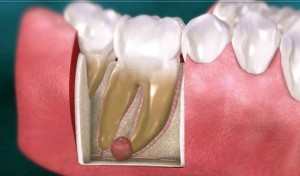What Is a Dental Cyst?
A dental cyst is very much like a closed sack. What is inside the sack can differ from patient to patient. Some cysts are comprised of air, some of soft tissue, and others are filled with fluid that can build up next to and around teeth. A dental cyst left to grow without treatment can lead to severe problems for your oral health.
Where Are Cysts Found?
There are various types of dental cysts.
Periapical cyst:-These cysts form at the root tip, and are typically caused by trauma, a crack in the tooth, or decay that has infected or killed the nerve (pulp) of the tooth.
Dentigerous Cysts: These cysts grow around unerupted or partially-erupted teeth, particularly wisdom teeth.
Keratocysts: These cysts typically form due to trauma or genetics. These cysts are aggressive and exhibit a high rate of recurrence, even after surgical removal.
Periodontal Cysts: These types of cysts are caused by advanced periodontal or gum disease, and thus are bacterial in nature.
Potential Oral Health Problems
A cyst left to grow can create unwanted pressure on teeth that can have the opposite effect on your smile. For example, a worsening cyst can eventually affect your bite by moving teeth, change the way you chew and digest food, and weaken the jawbone. In extreme cases of undetected cysts, the jawbone can actually be put at risk for fracture, among other complications.
Furthermore, a dental cyst can become infected and can eventually develop into an abscess, or pus-filled sack, which can spread the bacterial infection throughout your body.
Now that we have determined that cysts are bad, how will your dentist treat the cyst found in your mouth?
How to Treat Dental Cysts
The dental cyst will first require a thorough examination by your dentist or maxillofacial surgeon. The type of treatment used will depend on the type of cyst as well as where it’s located.
A cyst that forms on the root of a tooth might require endodontic or root canal treatment in order for the cyst to begin the healing process.




